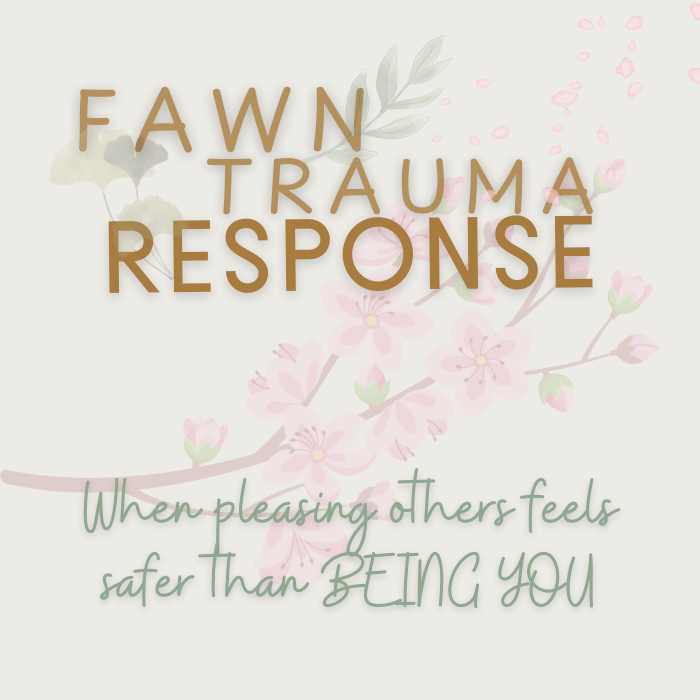How over-giving and self-abandonment can be signs of survival, not weakness
Most people are familiar with the “fight or flight” response.
But there’s another trauma pattern — quieter, more hidden, and often misunderstood:
the fawn trauma response.
It’s what happens when your nervous system believes the safest way to survive is to appease, accommodate, or please others — even at your own expense.
What Is the Fawn Trauma Response?
Fawning is a learned survival strategy that says:
“If I keep others happy, maybe I’ll be safe.”
It can look like:
- Saying “yes” when you mean “no”
- Suppressing your feelings to avoid conflict
- Over-apologizing or blaming yourself
- Always being “the helper” or peacemaker
- Feeling anxious when someone is upset — even if it’s not about you
- Avoiding authenticity to avoid rejection
Fawning isn’t a personality flaw.
It’s what many of us learned when love or safety felt conditional.
If you’d like to learn more about the origins of the fawn trauma response, this foundational article by Pete Walker offers deeper insight into how and why this pattern forms — and how it can begin to heal.
Some links on this page are affiliate links. If you choose to purchase through them, it supports this site at no extra cost to you. Thank you for your support. 🤍
Why We Fawn
Fawning often begins in childhood, in environments where:
- Anger or needs were punished
- Love was withdrawn as a consequence
- You were praised for being “easy,” “low maintenance,” or “selfless”
- Being “good” was the only way to feel secure
- Emotional attunement came from guessing what others needed — not being met in your own needs
In response, your nervous system became hyper-focused on others.
Staying connected — even through self-abandonment — became the safer path.
The fawn trauma response isn’t something you chose. It’s something your nervous system learned — to keep you safe in environments where your authenticity felt risky.
Signs You May Be Stuck in Fawn Mode
- You feel responsible for others’ emotions
- You struggle to express anger or boundaries
- You often feel invisible or disconnected from your true self
- You fear rejection when you show your needs
- You stay in relationships that feel one-sided
🪷 How to Begin Healing Fawn Patterns
Healing doesn’t mean becoming cold or selfish.
It means including yourself in the care you give.
Here’s where to start:
1. Gentle Self-Inquiry
When you say “yes,” pause and ask:
“Is this really true for me?”
“What am I afraid will happen if I say no?”
2. Practice Micro-Boundaries
Start small. Maybe you decline a text. Maybe you take space before responding. These are sacred acts of self-trust.
3. Feel the Fear — and Stay
Fawning is about avoiding disconnection. As you set boundaries, old fears may surface. This is part of the thawing process — not a sign you’re doing it wrong.
4. Reconnect With Inner Desires
Ask yourself daily:
“What do I want?”
It may feel unfamiliar. That’s okay. Keep listening.
5. Seek Safety in Authenticity
Start showing up just a little more as yourself. The people meant for you will meet you there.
Gentle Resources You Might Find Supportive
If you’re beginning to gently unwind people-pleasing or fawn patterns, these two resources offer different but complementary forms of support:
• The Disease to Please by Harriet Braiker
A practical, step-by-step guide for healing chronic people-pleasing. Helpful if you’re looking for clear insights into boundaries, saying no, and releasing guilt — with a structured, supportive tone.
• The Vagus Nerve Deck by Melissa Romano
This 75-card deck offers polyvagal-informed practices to gently support your nervous system through breath, movement, and emotional safety. Created for those navigating stress, fear, and self-abandonment — especially when words feel too far away.
There’s no rush. Even one small practice — one breath, one card — can begin to shift something tender inside.
FAQ
Is fawning the same as being kind or generous?
No — true kindness comes from choice.
Fawning comes from fear. It’s compulsive, anxious, and self-erasing.
Healing allows your generosity to become rooted in truth, not survival.
Can I stop fawning if it’s how I’ve always stayed safe?
Yes — but it takes time. Your system must learn that being you is not dangerous.
The more you experience safe connection while being authentic, the more the fawn response softens.
Next Pages That Might Support You:
- Healing Emotional Patterns
- Working Gently with Resistance
- Compassion as a Healing Tool
- Emotional Safety Practices
You don’t have to keep shrinking to stay safe.
You get to expand — gently, truthfully, in your own time.
Your unfolding is already underway — and it’s beautiful.

